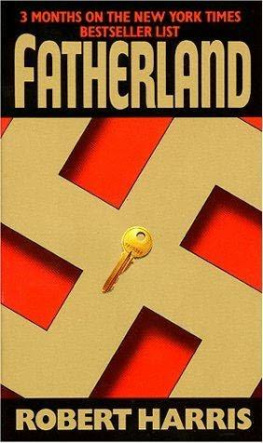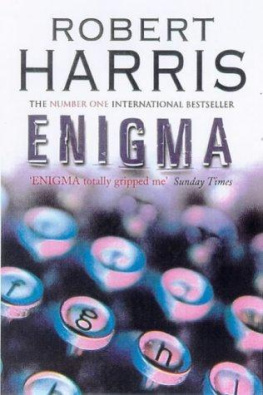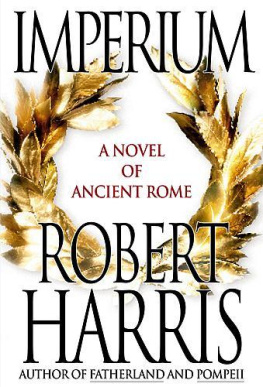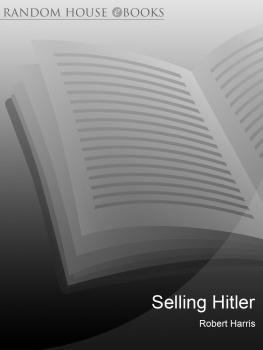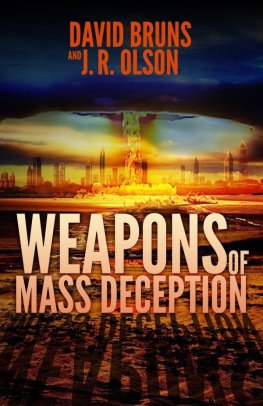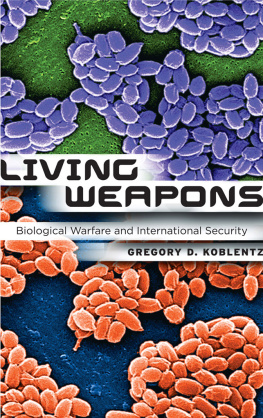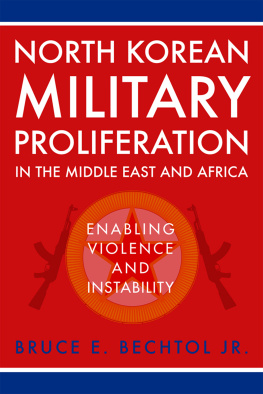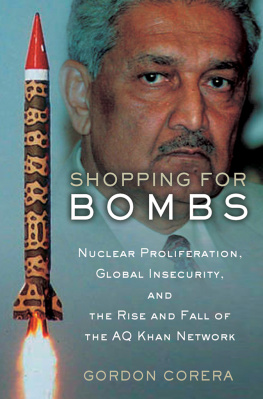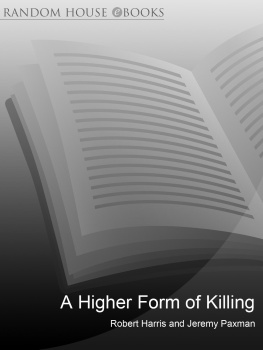Robert Harris and Jeremy Paxman
A HIGHER FORM OF KILLING
The Secret History of Gas and Germ Warfare
In no future war will the military be able to ignore poison gas.
It is a higher form of killing.
Professor Fritz Haber, winner of the Nobel Prize for Chemistry, inventor of chemical warfare, 1923.
This book grew out of a film we made for the BBC television programme Panorama, and we would like to thank Roger Bolton, Panoramas editor, for the encouragement and advice he gave us at that time, and for the understanding that he, and others at the BBC, have shown since.
Thanks are due to so many people who helped in the actual research of this book that we cannot list all of them here. Considerations of space aside, many felt free to talk only with a promise of anonymity.
Among those who can be mentioned, however, we must record our gratitude to the staff of the Public Record Office, the Imperial War Museum, Churchill College, Cambridge, the US Army Public Affairs Department, and Edgewood Arsenal, all of whom assisted with documents and advice. The Church of Scientology also made available to us documents they had unearthed in their campaign against chemical warfare. Among other individuals who gave us their advice and information thanks are due to General Allan Younger, Professor John Erickson, General T. H. Foulkes, David Irving, Lord Stamp, Air Marshal Sir Christopher Hartley, Professor Henry Barcroft and Paul Harris.
Nicholas Sims, Lecturer in International Relations at the London School of Economics, and Adam Roberts, Reader in International Relations at Oxford University, were both kind enough to read and comment on portions of the typescript for the publishers.
Additional research in Washington was carried out by Scott Malone.
We would also like to thank Jeremy Lewis of Chatto & Windus, without whose initial enthusiasm this book would never have been written; and Elizabeth Burke, who steered our battered manuscript into production.
Although it is invidious to single out particular individuals from the many who have helped us, two in particular deserve our special thanks. One is Dr Rex Watson, the Director of Porton Down, who, within the confines of the Official Secrets Act and with no guarantee of a good press, gave us invaluable assistance. With his approval, we also enjoyed the help and advice of Portons information officer, Alex Spence.
Our other great debt is to Julian Perry Robinson of the Science Policy Research Unit at Sussex University. He helped generously, both with time and advice, and read the book in its early stages, making many valuable suggestions. All students in this field owe Julian Perry Robinson a debt for the work he did in pulling together the information contained in the first two volumes of the six-part study of chemical and biological weapons published by the Stockholm International Peace Research Institute. Where we have drawn upon this, and upon the work of others who have investigated this subject in the past, acknowledgement is made in the notes at the end of the book.
If, despite the best efforts of all the above, we have made errors of fact or judgement, responsibility rests with the authors.
Robert Harris wrote chapters one to five of this book; Jeremy Paxman wrote chapters six to ten. The authors collaborated on chapter eleven.
INTRODUCTION

A Higher Form of Killing was the first book either of us ever wrote. It was published in 1982, fared reasonably well, was translated into German, and duly passed into honourable obscurity about a decade ago. We never expected to return to the subject.
But chemical and biological weapons have assumed a horrible importance again. Indeed, they are probably more of a threat to the security of the world now than they were twenty years ago, when Americas decision to develop a new generation of binary chemical weapons first prompted our interest in their history. Astonishingly, it seems likely that more people were killed by poison gas in the 1980s than in any decade since the First World War as many as 20,000 in the Iran-Iraq War alone. A type of weapon which most military experts thought to be obsolete, and which three generations of arms negotiators have sought to outlaw, has made a comeback and with a vengeance.
Chemical and biological weapons (CBW) frequently, and not inaccurately, described as the poor mans atomic bomb are instruments of mass destruction which were once within the reach only of the worlds most sophisticated nations. But the proliferation of technology has now made them readily available to such secondary powers as Iraq, Iran, Syria, Libya and North Korea. Indeed, Japanese terrorists have managed to manufacture one of the most deadly of all the nerve agents sarin in their own private facility. After the attacks on America of 11 September 2001, President George W. Bush declared that the world was at war with terrorism. It is, regrettably, fairly likely that at some point in the course of this war, the terrorists will try to strike back with at least one of the weapons described in this book. Five people have already died from weapons-grade anthrax in the United States. It is not, at the time of writing, clear where that anthrax came from, or who used it. But there are worryingly large quantities of weaponized anthrax in existence. The collapse of the Soviet Union, for example, has finally revealed the full extent of the Kremlins CBW arsenal. It must be regarded as a serious possibility that some of this material has found its way into new hands.
Our original purpose in writing this book was to put together the first general history of gas and germ warfare. It begins on the Western Front in 1915, when the Germans unleashed an attack using vaporized chlorine. It charts the growing escalation of gas warfare in that conflict, as each side sought to out-poison the other with new and more deadly weapons: phosgene, mustard gas, cyanide. It describes how the worlds powers then sought to outlaw chemical weapons, and how Nazi scientists developed a whole new generation of poison gases in the 1930s: the so-called nerve agents. It recounts the beginnings of the first major biological weapons programme in Britain, in the Second World War and tells how Russia and America eventually came to stockpile massive amounts of the most deadly toxins on the planet.
We describe it as a secret history because these weapons have generally been tested and manufactured clandestinely for obvious reasons. All methods of killing are distasteful, but there is something particularly repulsive and shameful about the use of chemicals and germs. They are, first and foremost, indiscriminate weapons dirty, as one young soldier we met during our researches put it. They rely for their effectiveness on taking their victim unawares. By and large they are invisible, and do their damage from within the body. You may not see the bomb or bullet that kills you, but that external threat is somehow cleaner than the malignant tumour, the paralysis or suffocation inflicted by these unseen weapons.
Poison gas and germ weapons turn civilization on its head. Diseases are not fought, but carefully cultivated; doctors use their knowledge of the functions of the human body to devise ever more effective means of halting those functions; agriculturalists deliberately induce fungi and develop crop destroyers. The chlorine that poisoned our grandfathers at Ypres came from the synthetic dye industry and was available thanks to our grandmothers desire for brightly coloured dresses. Modern nerve gases were originally designed to help mankind by killing beetles and lice; now, in the hands of the military, they are insecticides for people. (Indeed, if you want to imagine the effect of a nerve agent on a human being, the frantic death of a fly sprayed by an ordinary domestic insect-killer gives an approximate picture.) Chemical and biological warfare, as one writer has put it, is public health in reverse.



